God of War III was an epic game for certain, but its dark tone, and heavy-handed storytelling left me cold. I’d play through it at least once a year, every year since it came out in 2010. It made me appreciate the combat, combo system, level design, and other elements that went into it, but it also made me look at the things I didn’t care much for. The game didn’t hit the same notes that the previous two had. At least not to me. The kid that was obsessed with mythology, with the pantheon of gods, and titans was still very much within me. I enjoyed going on a grand adventure with Kratos, instead of watching him foam at the mouth in high resolution. There were a couple of GoW titles released for the PSP, but I didn’t play them because I didn’t own a PSP. The developers at Ready at Dawn were asked to re-release the games as the Origins Collection for the PS3. I didn’t buy the game when it came out. Instead I shifted my attention to other titles over the years. I even got a PS4, and PS5 before I decided to revisit the games I never got around to. When I picked up the Origins Collection, as well as the GoW Saga, which were HD remakes of GoW, and GoWII, included with a copy of III for the PS3. I must have played through the 2018 version of God of War seven or more times when it came out. I enjoyed the change in tone, and game play when compared to GoW III. God of War Ragnarok was announced for November 2022, just in time for my birthday! I decided to do my annual play through of the series at least a month before it came out. That was my excuse to buy the PSP games that I hadn’t played before.
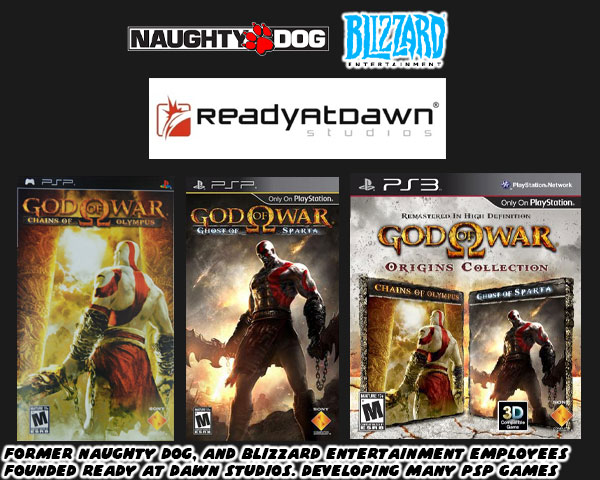
Ready at Dawn Studios was not simply going through the motions, as I assumed they had. They created a game that was every bit as good, if not better in some regards to the work coming out of Sony Santa Monica. I learned that some of the founders had worked at Naughty Dog, and many of those people had cut their teeth on the first two GoW titles. It stood to reason that such A-List talent would be able to deliver an actual GoW experience. As I went through each title released in chronological order I found myself going through the Origins Collection, and God of War Ascension more times than any other game. I think the time away from the classic adventures helped me appreciate the work that went into them. It helped me figure out the elements that I enjoyed best about the franchise. It was what I communicated to my cousin when he asked me if I thought Ragnarok was going to be game of the year. It was the conversation that launched this series of blogs. I’d like to explore the Chains of Olympus in detail with you. I want to break down the entire story, and elements that spoke to me as a mythology geek. Let’s start with the setting of the game.
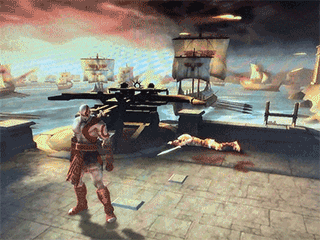
Like all GoW games we find Kratos in the middle of the action. The Persians are attacking the city of Attica from their fleet. This was an actual conflict, and location from history. The Spartan naval commander Eurybiades dies while taking bolt fire from the ships. Kratos dispatches the Persians, and joins several Athenian soldiers.
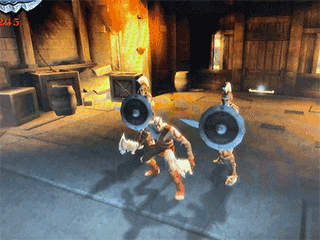
During that era the Spartans didn’t care much for the growing power in Athens, however they knew that the Persian army would destroy the Mediterranean kingdoms unless their armies, and naval forces united. Although not stated in the game I could imagine that Athena had dispatched Kratos to ensure the Persians would not capture the city. It was a wise choice given that the invaders had brought with them a Basilisk. The enormous creature appeared suddenly and devoured a cyclops with a single bite. Those that are familiar with the series know what a fight the one-eyed creatures give Kratos. Seeing the sea monster snack on it, and then turn its attention to Kratos set the tone for the game.
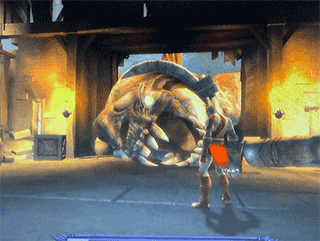
From a pacing perspective this was about how long it took the Hydra to appear in the original God of War. Ready at Dawn Studios, and particularly Director Ru Weerasuriya, was using a rock solid template. The encounters, exploration, and puzzles would be paced just as they were in the first game. The one I considered close to perfection. As Kratos took the eye of the Basilisk, and chased it off I knew that it wouldn’t be the last time they crossed paths.
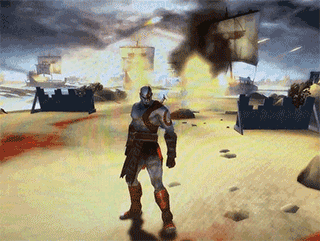
Kratos ran through a beach under siege. Flaming bolts from the Persian fleet were falling down all around. He broke into the city using a battering ram, and fought wave after wave of the invaders. Eventually he found the leader of the army. A massive Persian King wielding an enormous scimitar took on the Ghost of Sparta. His men would try to stab Kratos in the back, as he focused on the rotund leader. The King had his own magic attacks that he would summon when his sword wasn’t enough. Of course it was only a matter of time before Kratos could best the leader in combat.
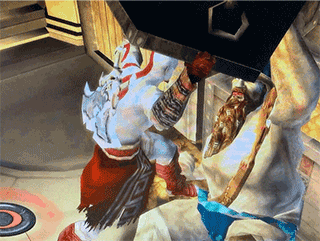
The King begged Kratos for mercy. He offered the Spartan money, women, and power. Kratos declined the bribe, and instead bashed a treasure chest over his head. He then took the magic vessel away from him. Contained in a small golden chest was the spirit of the Efreet (sometimes written Ifrit). It was a demonic fire spirit from Arabian mythology. Kratos could summon it, and even spend Red Orbs on it to make the magic stronger. This was the first magic attack collected in the game, and also the first time that Greek, and Middle Eastern mythologies were intertwined in canon.
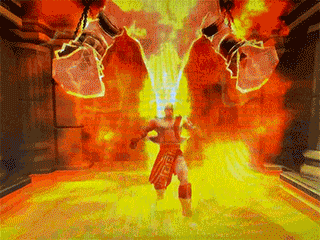
You could imagine that the mythology geek in me was losing his mind. Kratos had access to a magic lamp, and a demon that would fight for a few seconds on his behalf. Although the mechanic was similar to the Atlas Quake in GoW II, it was still an awesome sight. At this point players could earn a short break (a sex mini game) with some slave girls that the evil King had captured. They were very grateful to Kratos for liberating them!
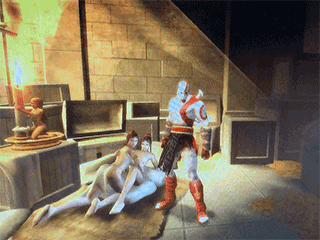
As I went through the city of Attica I valued the look, architecture, and details that Ready at Dawn had poured into the game. There were fruit stands in the market, no doubt abandoned during the invasion. There were Athenians fighting Persians in the streets, and rooftops. There were burning temples, and streaks of blood where the invaders had struck, and then moved on. We could see the Basilisk burning down the city, and climbing all over the buildings in the distance. Best of all everything was well lit so I could appreciate the sights, and sounds of a war. Unlike GoW III I wouldn’t’t have to turn up the brightness on my monitor to make out the details.
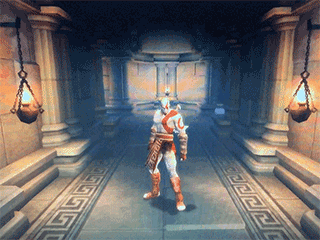
Kratos fights all the way through the city, and ends up at a destroyed bridge. The open space could mean only one thing. A boss fight was coming up.
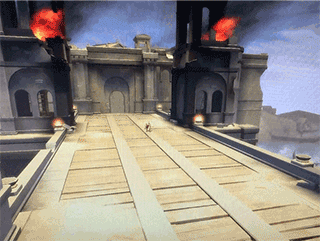
The Basilisk appears, and instantly tries to devour the Ghost of Sparta.
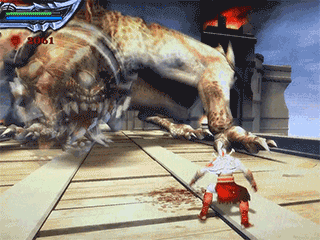
Kratos, and the beast fight tooth, and nail. Of course it was just a matter of time before Kratos got the upper hand.
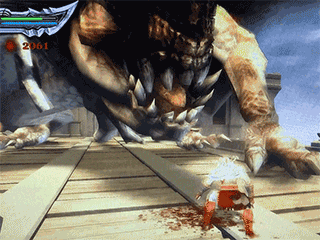
He manages to hook his Blades of Chaos into the jaw of the beast, and with a pull rips the head off the creature.
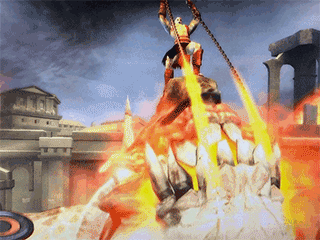
It’s a brutal end to a fantastic battle. Just like the Hydra in the original game this was going to set the tone for the rest of the title. At least I thought it would move smoothly to the next portion.
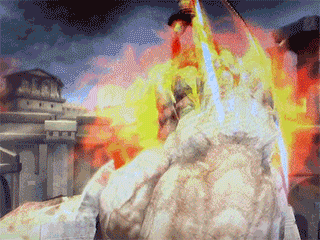
With the Athenians, and Spartans pushing back the invaders in the background Kratos yells to the heavens. He wants to know if he is nothing more than an errand boy for the gods. The sun suddenly falls from the sky, and crashes in the distance with a powerful explosion. Kratos can tell something is terribly wrong, and runs to investigate. This is how the first chapter wraps up, and instantly has me wanting to learn more. We’re going to reveal the layers of the game in the next blog. I hope to see you back for that. If you had a PSP, or played the game what did you think about it? Did you have a favorite memory with this or the Origins Collection. Let me know in the comments section please. As always if you would like to sponsor me
please visit my Patreon page and consider donating each month, even as little as $1 would help make better blogs and even podcasts!




























No comments:
Post a Comment